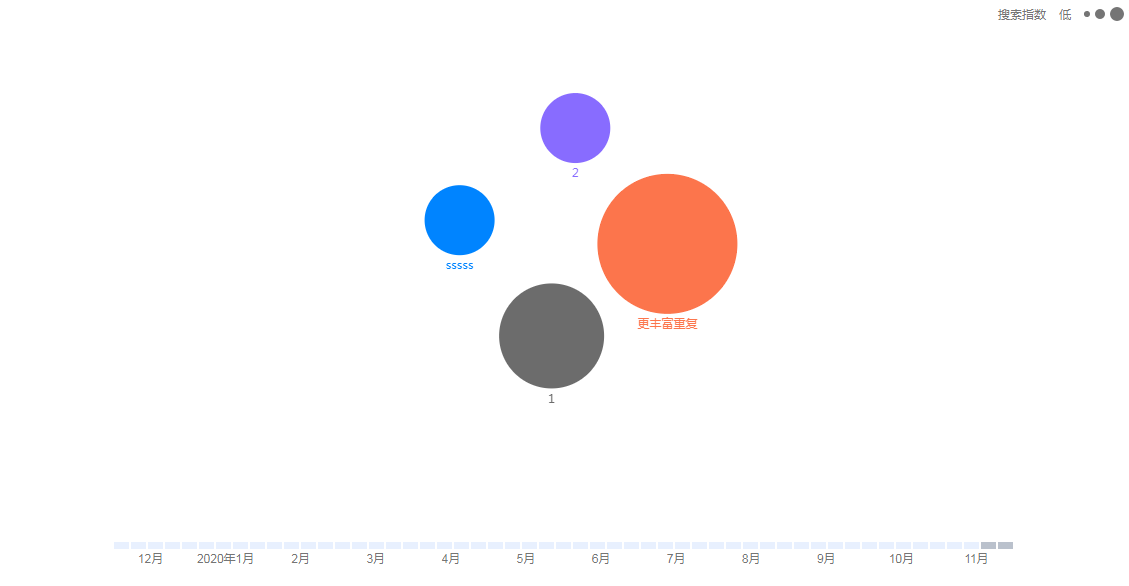自制时间轴组件封装
最新项目的一个时间轴选中样式,磨了我很久,刚开始想的是找网上的插件,但是发现没有,
先给大家看一下我要完成的样式(使用该组件我指定的年限范围是一年,大家可以根据自己的需求,稍作更改)

就是图片下方的时间轴,要根据上面时间的选择范围变化,发现网上没有,于是自己和同事一起手写了一个。
先上代码
<template> <div class="drag-wrep"> <ul class="list"> <li class="time start" ref="Start"></li> <li v-for="(item, index) in endWeek - startWeek" :key="index + 'px'" class="time" :style="'left:' + (startInit + 17 * item) + 'px'" ></li> <li class="time end" ref="End"></li> <li class="item-li" v-for="(item, index) in 53" :key="index"></li> </ul> <ul class="list list-month"> <li :class="{ 'month-start': day < 10, 'month-center': day >= 10 && day <= 20, 'month-end': day > 20 }" class="item-month" v-for="item in month" :key="item.id" > {{ item.name }} </li> </ul> </div> </template> <script> const initMonth = [ { name: "1月", id: 1 }, { name: "2月", id: 2 }, { name: "3月", id: 3 }, { name: "4月", id: 4 }, { name: "5月", id: 5 }, { name: "6月", id: 6 }, { name: "7月", id: 7 }, { name: "8月", id: 8 }, { name: "9月", id: 9 }, { name: "10月", id: 10 }, { name: "11月", id: 11 }, { name: "12月", id: 12 } ]; export default { props: { daterange: { type: [Number, String, Array, Object], default: () => [ parseInt(new Date("2020-09-30T16:00:00.000Z").valueOf()), parseInt(new Date("2020-10-30T16:00:00.000Z").valueOf()) ] } }, data() { return { startInit: 0, // 左边的初始位置 startTime: 0, endTime: 0, startWeek: 0, endWeek: 0, month: [], day: new Date().getDate() }; }, created() { this.dealTimeAxis(); }, methods: { dealTimeAxis() { // 处理时间轴 let month = new Date().getMonth() + 1; let year = new Date().getFullYear(); let newArr = initMonth.filter(item => item.id <= month); if (month != 12) { newArr[0].name = `${year}年1月`; } let oldArr = []; for (let i = month + 1; i <= 12; i++) { oldArr.push({ name: `${i}月`, id: i }); } this.month = oldArr.concat(newArr); }, dealStartTime(val) { // 处理开始时间 this.startTime = parseInt( new Date().valueOf() - new Date(val).valueOf() ); this.startWeek = 53 - Math.ceil(this.startTime / (24 * 60 * 60 * 1000) / 7); this.startInit = this.startWeek * 17; this.$refs.Start.style.left = this.startInit + "px"; }, dealEndTime(val) { this.endTime = parseInt( new Date().valueOf() - new Date(val).valueOf() ); this.endWeek = 53 - Math.ceil(this.endTime / (24 * 60 * 60 * 1000) / 7); this.$refs.End.style.left = this.endWeek * 17 + "px"; } } }; </script> <style lang="scss" scoped> .drag-wrep { margin-top: 100px; width: 100%; height: 100px; // background-image: linear-gradient(to bottom right, red, yellow); .list { display: flex; position: relative; .time { position: absolute; top: 0; width: 15px; height: 7px; background: #bac1cc; margin: 1px; cursor: pointer; } .start { left: -1700px; } .end { left: -1700px; } .item-li { width: 15px; height: 7px; background: #e8f0fe; margin: 1px; } } .list-month { width: 901px; justify-content: space-between; .item-month { width: 77px; font-size: 12px; font-weight: 400; color: #757575; } .month-start { text-align: right; } .month-center { text-align: center; } .month-end { text-align: left; } } } </style>
就是,这个组件,先给大家讲一下思路。
首先是样式,通过ul,和li实现。因为我们是一个格子是一周的时间算下来一年大概要53个,通过循环,先将格子实现出来,再修改样式
然后先设置list为相对定位,然后里面再定三个li,这三个li就是被选中的样式,设置为绝对定位,每个格子的大小大概是17px。
<ul class="list"> <li class="time start" ref="Start"></li> <li v-for="(item, index) in endWeek - startWeek" :key="index + 'px'" class="time" :style="'left:' + (startInit + 17 * item) + 'px'" ></li> <li class="time end" ref="End"></li> <li class="item-li" v-for="(item, index) in 53" :key="index"></li> </ul>
然后通过接收外面传过来的起始时间和结束时间来实现选中样式。
然后在用一个昂发来处理时间轴的位置。和显示的文字内容。



